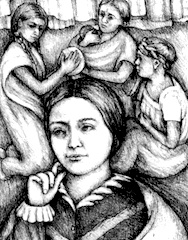|
J. William T. "Bill" Youngs, American Realities, Volume One:
Historical Episodes from First Settlements to the Civil War, Chapter Thirteen |
"Spirit of the Frontier," by John Gast, courtesy of the Wikipedia Commons
|
13. Manifest Destiny
|
SummaryDuring the 1840s, American expansionists dreamed of occupying the continent from sea to sea. The Southwest belonged to Mexico and the Northwest was jointly controlled by England and the United States, but supporters of “manifest destiny” argued that God had ordained these lands for exclusive use by the American people as a showcase for liberty and democracy. Through diplomatic negotiations in 1846 the United States was able to gain the Oregon Territory, then a wilderness. The Southwest, however, had been settled for more than two centuries by immigrants from Mexico and could not be won by peaceful negotiation. In 1845 the United States annexed Texas, which had fought for its independence from Mexico in 1836, and in the next year the United States went to war with Mexico. By 1848 the United States had gained a million square miles of territory, all carved out of Mexico. The moral problem inherent in spreading democracy by the sword was evident in the experience of a trader’s wife, Susan Shelby Magoffin, and other American civilians and soldiers who entered New Mexico in 1846 with Gen. Stephen Watts Kearny and the Army of the West.
|
Author reads from the Text
A few days later General Kearny reached the first Mexican settlements. At the village of Las Vegas he organized a ceremony that he would repeat again and again in other villages: he called together the religious and civil leaders of the town, explained that New Mexico was now American territory, and administered an oath of allegiance. In Las Vegas he stood on one of the flat-roofed adobe buildings with two Mexican army captains and the alcalde, or mayor, and addressed a crowd of 150 villagers. He had come by order of the United States to take possession of New Mexico, he told them. He had a strong force with him, and another American army would soon join the first. The people were absolved of allegiance to Governor Armijo and Mexico and now must give their allegiance to the United States. Kearny emphasized the advantages they would gain with American citizenship. The United States would protect them from Indian raids, which were common throughout New Mexico, and would guarantee their personal and religious liberties. The American government, he declared, would “protect the poor man as well as the rich man.” The alcalde and the two captains then swore an oath of allegiance to the United States. Kearny shook their hands and turned to the crowd. “I shake hands with all of you through your alcalde,” he said, “and hail you as good citizens of the United States.”
Several soldiers in the Army of the West wrote accounts of the public reaction to the ceremony. One said that the people appeared “perfectly friendly,” another said that they raised “a general shout,” and a third said they raised a “faint shout.” But several observers observed some hesitation on the part of the Mexicans. One soldier noted in his journal that the oath was clearly taken under compulsion. “These poor creatures,” he wrote, “were evidently compelled to take it for fear of giving offense to our army.” Another soldier recorded with irony that “the great boon of American citizenship,” was thrust “by the mailed hand” upon the Mexicans.
Several soldiers in the Army of the West wrote accounts of the public reaction to the ceremony. One said that the people appeared “perfectly friendly,” another said that they raised “a general shout,” and a third said they raised a “faint shout.” But several observers observed some hesitation on the part of the Mexicans. One soldier noted in his journal that the oath was clearly taken under compulsion. “These poor creatures,” he wrote, “were evidently compelled to take it for fear of giving offense to our army.” Another soldier recorded with irony that “the great boon of American citizenship,” was thrust “by the mailed hand” upon the Mexicans.

